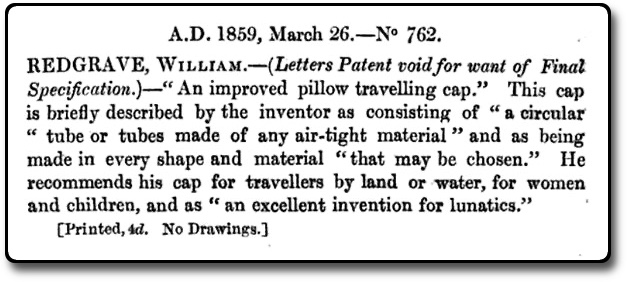William Redgrave’s Safety Travelling Cap
The British patent office granted William Redgrave two patents. The first (No. 2888 - 1853) was for a "safety travelling cap". The second (No. 762 - 1859) was for a "pillow travelling cap". However, the two patents seem to describe the same invention. They just emphasize different uses for it.
Redgrave's patented cap consisted of three air-tight, circular tubes that would wrap around a wearer's head. His idea was that this would provide a measure of safety for travelers, because if the traveler fell the inflated tubes would cushion his head:
The cap could also serve as a pillow (thus, the second patent):
Finally, Redgrave noted that the cap was "an excellent invention for lunatics." Presumably because lunatics might fall over a lot. Or hit their head against a wall.
Unfortunately Redgrave provided no drawings of his safety cap.

Redgrave's patented cap consisted of three air-tight, circular tubes that would wrap around a wearer's head. His idea was that this would provide a measure of safety for travelers, because if the traveler fell the inflated tubes would cushion his head:
Thus, should a person wearing it be violently thrown against the sides of a railway carriage or in contact with a person on the opposite seat to him, or be thrown from a carriage, chaise, or any other conveyance, his head is perfectly secure from injury.
The cap could also serve as a pillow (thus, the second patent):
A person wearing the cap can repose with the greatest comfort in any position, quite as well as if he had a pillow placed beneath his head, and is werewithal as light as any ordinary cap; it is excellently adapted for travellers to and residents in hot climates, forasmuch as they can throw themselves on the deck of a vessel or anywhere else, and enjoy a most comfortable repose.
Finally, Redgrave noted that the cap was "an excellent invention for lunatics." Presumably because lunatics might fall over a lot. Or hit their head against a wall.
Unfortunately Redgrave provided no drawings of his safety cap.

Comments
Commenting is not available in this channel entry.

Category: Inventions | Patents | Headgear | Nineteenth Century